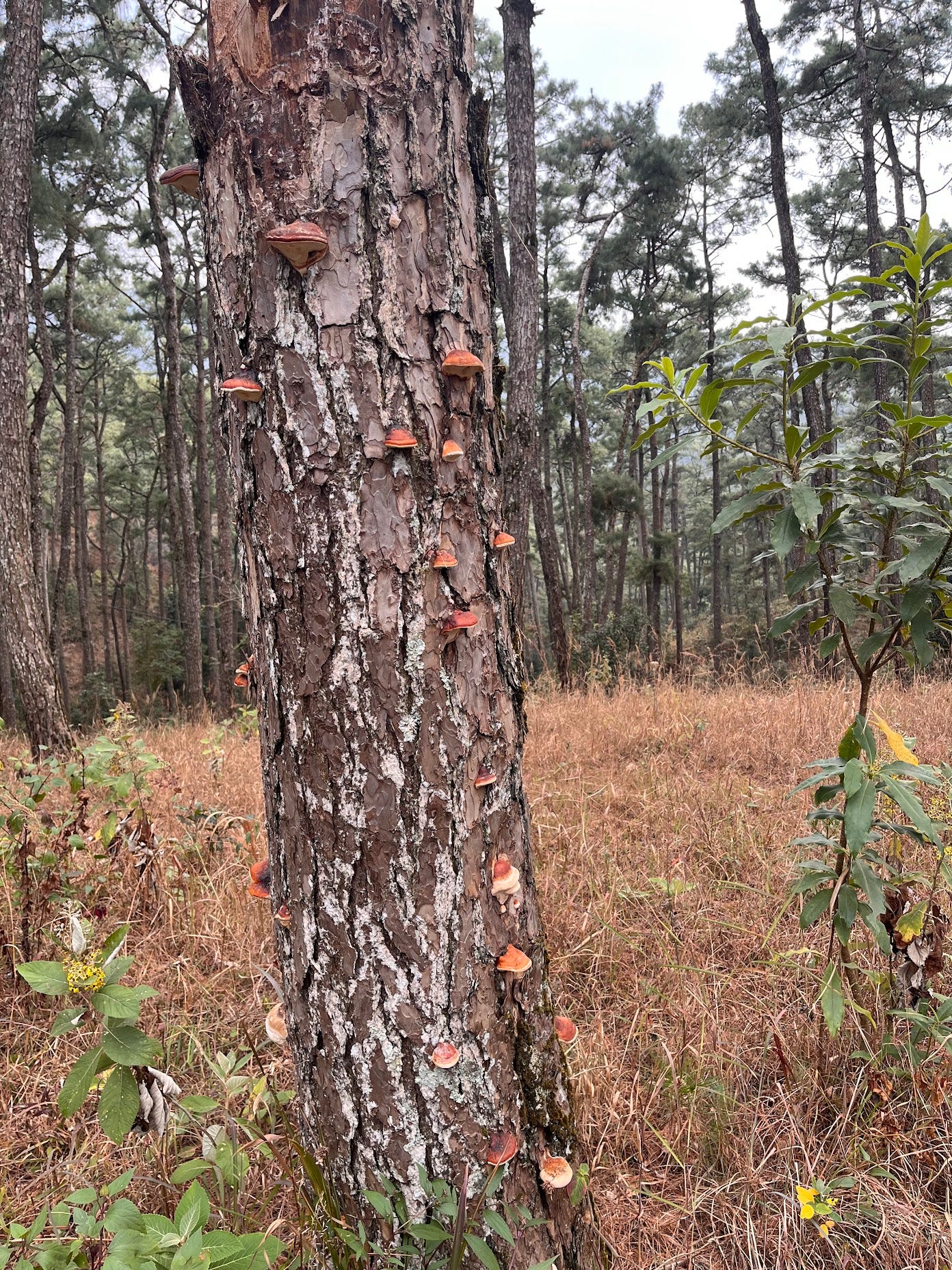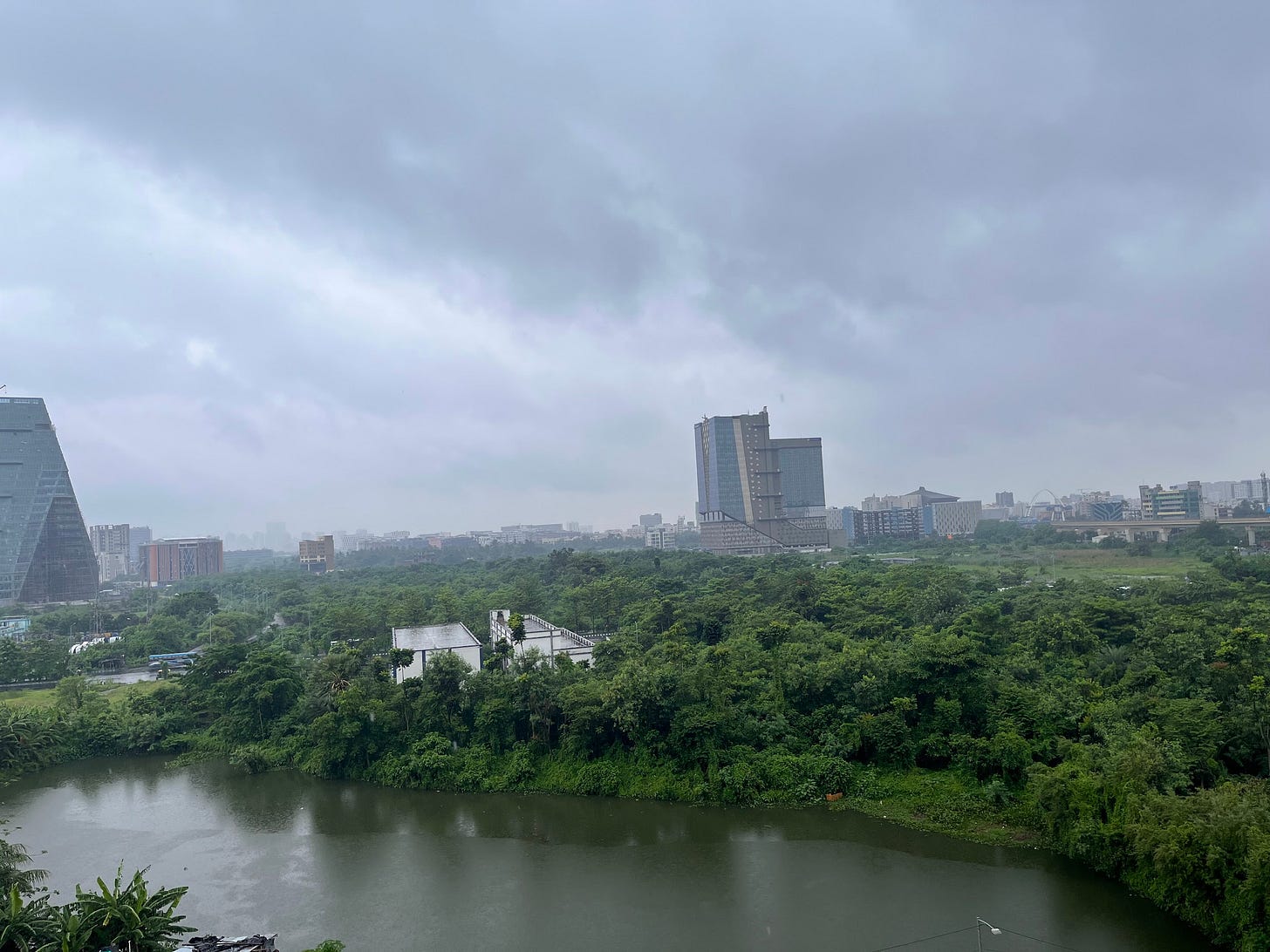Blue-grey horizons dominate the plains, plateaus, valleys, and hills alike as the subcontinent is rejoicing in summer’s loosened grip. I am relieved by the dispersal of hot grief of summer, for it held traumatic memories of the past year. In a happy addition to the party, the muse has decided to whisper again in hushed murmurs of rain-soaked earth and liminality of purple fault lines of thunderstruck monsoon skies. I am but a pellucid ghost to the events of my surroundings – a mere observer of the vastness of experiences, to the flow of the whole range of human emotions. I am but a collective of stories of all the ancestors now called by a name. In certain moments, I am not even there anymore, happily lost in the rhythmic happenings rather than staying fixated.
The dreams of dirt are hidden in my subconscious like hungry beasts, demanding my attention, now so long averted by the inner turmoils of my life. ‘What about me’, the Earth says, the mother of dirt and life. Yes life, the congenial twin of dirt — its life-long companion. Life — me, I am life. Visions awaken in wide vistas of untrimmed forests standing in front of my window. Gigantic green monsters of curiosity gazing towards infinity. After long meditation, immersed in its crude beauty, I almost always lose a sense of self. Am I looking at the forest, or is the forest looking at me?
Mother Earth invites me into her secret chambers of revelations. ‘Stay here’ she commands. She speaks in limited syllables. I crave these visions of magnificent green vistas and dreams of black dirt. They evoke in me a spiritual deliberation like no other — a primordial angst to yield after being touched by beauty. Yet I know, I am a being of flesh and blood — too corrupt, too exposed to the incredulities of humans, to receive a permanent welcome here in these dreams of dirt.
With such dreams arrive flashes of childhood, memories rooted in wonder of rot and decay invariably mixing with the dirt. I remember the toddler me in my father's garden of roses, marigold, and dahlia — getting stung by overgrown spiked vines and chased away by garden bugs. My wonder at the workings of the earthworm’s segmented body, on how it moves in and through the soil with such a delicate frame. It is only now that I understand, it takes colossal strength to move softly through this world. For a toddler, the broad-trunked 30-foot-tall jackfruit tree was a mammoth-like presence. I lay down on the cemented courtyard and watched it boldly stand against the afternoon sun, pouring in like liquid gold through its canopy. One day I became aware for the first time of its ability to be laden with gigantic fruits hanging from its trunk. The strength it takes to bear a life upended by the weight of ability. In my childlike gaze, the tree was God and so were the bugs — life seamlessly bearing witness to its own manifestations.
I saw my father work through mud and soil — his way to return love to this broken world. I remember dirt adamantly sitting underneath his fingernails, which he was never in a hurry to wash away. There is beauty in accepting the messy bits of life — to let it cling to our bodies — the sweat, the soil, the broken things fitting right into the mosaic of life. Papa gathered jackfruits in a jute bag, so heavy that he had to carry it on his back. Jackfruit cutting is ceremonial in the sense that it took a lot of patience. The jagged shell conceals a gluey and sticky underskin, which then reveals the sweet-fleshed seeds. A jackfruit is a universe of taste, smell, and texture waiting to be experienced. My father would sit on the floor with his hands dipped in coconut oil, to prevent them from the sticky mess of the jackfruit cutting business. He would press the knife halfway through the giant's body, then dig in both hands and split it open from the inside.
There is a certain rawness to the whole process, but it is the kind that helped us evolve, the sheer force of mind and body that kept our ancestors surviving against all odds. However, the ultimate truth of life is far beyond our survivalist brain. The truth is in the malleability of our nature — in the careful surrender to the tides of changes of this animal body — in the impermanence of existence. The brute force, the strength fade as we age, but the softness persists. It remains a compassionate mentor walking us through the rough parts of life. I saw my father fade into softness with humility and grace. I pray to find the same grace, when time comes to prepare for the end of my human days.

Monsoon also evokes a pertinent sense of decomposition. The other day my attention was arrested by a millipede crawling inside the attic room attached to my parents’ terrace garden. I watched the harmless being lift its thousand tiny legs in rhythmic sine-waves. I was awestruck by its determination to move. This little being with its little animated body is significant in this world. It is willed into existence because it is necessary. Millipedes are some of the most active decomposers of our ecosystem. They feed on decaying plant material like dead leaves, wood, and other organic matter, breaking them down into absorbable nutrients promoting soil fertility. If we look long enough into this vitality of decomposition, the necessity of decay in nature, we would realize that these morbid agents of decomposition are actually propellants of life. Millipedes are seen as undesirable pests in farming communities because of their tendency to sometimes encroach on healthier leaves. It makes the farmers furious when millipedes act on their own volition and move beyond the roles desired for their existence.
Isn’t that how our societies respond too? When those believed to belong to the margins—the decomposers — the invisible laborers, the migrants—begin to move beyond the roles assigned to them. This is more evident now than ever with all the outcry against immigration in the western world. Anti-immigration sentiments in Europe are reported to be at an all-time high since the Second World War. Is it merely coincidental, then, that this surge in hostility corresponds with a proportional rise in the non-European middle class across the continent during the same period?
As more immigrants—especially from Asia, Africa, and the Middle East —moved into middle-class professions like tech, medicine, education, public services — their increased visibility challenges the older, often unspoken, racial and cultural hierarchies of Europe. What once could be tolerated as "working-class" immigrants doing "essential but invisible work" now becomes threatening when non-Europeans are seen as peers—or even superiors—in social, professional, and academic spaces. The growth of a confident, upwardly mobile non-European middle class is sometimes framed in populist rhetoric as a cultural threat rather than an economic benefit. The anxiety isn't just about jobs—it's about schools, neighborhoods, languages spoken in public, and the visibility of "other" religious or cultural norms. The fear is about losing control over the narrative of who is allowed to thrive, and who must stay in the soil, quietly breaking things down.
But the soil has a cognisance of its own. It reveals truth as it is, rather than entertaining its various projections. The soil — an accumulation of dust, rock, minerals, water, compost and the decomposers. Everything living, sustaining, interdependent on a continuous cycle of decay and growth. Everything belongs here, in the soil. This truth cannot be dislodged by propaganda. Human society too works alongside the fractal intelligence of nature. We too are growing more integrated into the world — more globally attuned rather than away from it. And if we try too much to interfere, the cycle of nurture will break, and so will our world.
The world is in upheaval, with new wars breaking out every year, but I am concerned about more than just nuclear warfare. It is the slow erosion of genuine goodness in ordinary people that worries me. There is a pervading tiredness in communal life, a kind of quiet exhaustion that creeps into everyday interactions. People’s capacity for compassion is slowly reducing, not with a crash, but with a long, low fade.
I am beginning to wonder if the real terror is not war, but the dulling of tenderness. The breakdown of the soft architecture of hope. Disruption in the linearity of longing — that silent rhythm we rely on to imagine a better world — is far more powerful in degrading the creative faculties of the collective than something as visibly threatening as a nuke. Being forced to live in a world devoid of hope and compassion is, in many ways, as horrifying as facing an obliterating weapon of destruction.
Imagine a world where the soil is no longer a living, breathing witness to life, but reduced to sterile dust. A world where nothing decomposes, nothing nourishes, and nothing begins again. That is the true horror — a future where the earth no longer dreams.
And yet, we still have a choice. We can dig our heels into the dirt — into the mess, the rot, the decomposition — and let it teach us again what it means to belong to one another. The soil reminds us that everything is part of the same cycle — decay, nourishment, growth. It holds the wisdom of interdependence. If we listen closely, it may still show us how to return to the truth of life: that nothing thrives in isolation, and nothing is too broken to begin again.
Berkana is a non-stripe based reader-supported publication. To support my work, consider becoming my patron through Paypal.



Thank you for this beautiful reflection on the holiness of dirt. When I taught gardening classes to kids a few years back, the lessons on compost bordered on the spiritual. It was miraculous to watch children awakening in real-time to a deeper understanding of the life-death-life cycle, and where they fit into it. I love the way you’ve brought millipedes, as real animal and also as metaphor, into the picture. I’ll be thinking about that one for a while.
As she circles her last moments, I've been revisiting much of the wisdom of Joanna Macy, and I can see that you've been blessed with a knowing and a seeing not dissimilar to hers. It's so important. This kind of clarity. Thank you for sharing it 💛